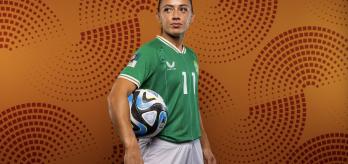Her capacity to keep her eyes on the ball as it travels quickly, and her use of her body to interact with both the ball and the rival player, require focus, game intelligence, physicality, courage and strength. Her awareness of where the danger is and when an intervention simply must be made are exceptional, and this is why she is renowned as a world-class defender.
In the following clips, we see some stunning examples of Paredes’ impeccable timing as she makes crucial, no-nonsense tackles in big moments of big games. Her range of tackles includes “Standing” tackles, “Body” tackles and “Sliding” tackles.
Key insights
-
The defending player must have their eyes on the ball in the lead-up to making a tackle. In addition, they also need to know where they are in relation to their own goal, and should be positioned between the ball and their own goal.
-
Precision timing is vitally important, particularly when making sliding tackles. If the tackler completely fails to make the tackle, they could find themselves eliminated from the game phase. Alternatively, if they make contact with the opposition player instead of the ball, they could end up committing a foul or, if excessive force is used, injuring the opponent.
-
When the time is right, the defending player must have the courage to commit to the tackle and use their body strength to make a strong, decisive intervention.
Timing the tackle
In preparation for making a tackle, the defending player keeps their eyes on the ball to help them acquire the information they need about how fast the ball is moving and its proximity to the attacking player. This way, if the attacking player takes a heavy touch on the ball, this gives the defender a moment of opportunity to make a tackle.
In addition, the defending player should ideally be positioned “goal-side” – that is, between the ball and the goal they are defending in the build-up to a tackle. Any covering defenders between the defender in the 1v1 and the goal can communicate to let them know there is cover inside, giving them greater confidence to commit to making the tackle. However, in some situations, the defender will know they are the last player and that they simply have to make a challenge.
Paredes is exceptional in her judgement when it comes to timing the tackle, as well as when using her body strength and physicality to execute it. The muscles of her standing leg are fully engaged as she propels her tackling leg with full extension and reach to make a decisive connection with the ball. She uses her upper body and core strength to protect herself in the aftermath of the connection with the ball, and to help her withstand any impact with her opponent.
Her technical and physical attributes are fundamental to her ability to make these tackles, but so too is her ability to read the game. Positional awareness, good judgement, confidence and courage are absolute prerequisites when executing this skill. There are times when making a strong tackle will hurt and, in these examples, Paredes demonstrates she is not found wanting when her team, and the situation, needs a commanding and impactful intervention.
In the images below, we see a great example of how Paredes applies these principles in a dangerous defensive situation against Zambia forward Barbara Banda, one of the fastest attacking players in the women’s game.
Summary
Irene Paredes is a powerful, courageous and impactful defender. In dangerous 1v1 situations, she understands where she needs to be in relation to the goal she is defending. Her laser-like focus on the movement of the ball and its proximity to the attacking player allows her to judge the perfect time to perform a tackle.
The physical strength she exerts through her standing leg propels her to gain the maximum (or required) reach with her tackling leg, thus ensuring she makes full contact with the ball, and does not foul her opposing player.
Her courage, confidence, timing and upper-body strength allow her to commit fully to making the tackle. This is particularly crucial in last-ditch situations, where a missed or mis-timed challenge could have repercussions for her and her team.
Big-game players stand up in crunch moments and deliver for their teams – and Paredes is the very definition of a big-game player.



















